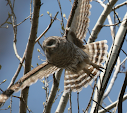I am one who believes that without a plan or goal there is no growth or development. It is why so many of us, (myself very much included), find ourselves wondering where the weekend went, and why everything seems to have slipped into a repeatable routine. This blog has been a part of two years of my life where I have attempted to break that pattern, at least in one part of my life. Two years ago I found that too much of my life was slipping by, with highlights being sporting events viewed on tv or social events that too easily blended with one another. Don't get me wrong, I still like hanging out with friends and watching a good football or hockey game, but I needed something to kick me out of the rut, and make the times that I chose to partake in those activities more meaningful by their scarcity.
So year one was all about getting out of the house more and just spending more time in the outdoors. In October of that year I started actually keeping a bird list and dragging a camera around to see what I could digitally capture.
By the beginning of last year I had found that both photography and birding were pass times that I enjoyed, but that if they were going to be anything more meaningful than replacing time spent watching sports with time spent slowly walking and watching for birds I would have to find a way to push myself. I did so in two ways. First, I fired up the old Blogger and started DaveABirding. It gave a purpose to my photography and also exposed me to a higher level of accountability in my birding. In the past year I have been exposed multiple times posting incorrect species identities. I don't mind making mistakes, it is how we learn, but I find it keeps me much more conservative in my assumptions when I know I will have an audience evaluating my finds.
A bit later last year I pushed myself out of the comfort zone again. I started exclusively manually focusing my shots. Sure for the first few weeks I had a lot of fodder for the virtual cutting room floor, and less quality to post, but in the long run it has really helped me grow. Now I can confidently tighten my focus on a sparrow in some brush, and know that I am getting close to focus on the sparrow's eye, not a clear shot of a branch five feet in front of it.
So to continue to grow I have set several photographic and birding areas for improvement this year. The birding has been mentioned several times in the past, developing an improved ear for bird calls. I have an iPod now with iBird, and the Smithsonian Field Guide with calls, so there is a start, and hopefully I will be able to drive myself to rely more on my ear and develop my mental catalogue from which to draw.
Photography is poised on a more painful growth spurt. I enrolled in my first instructor led photography course. Intellectually the material is not new, I get the concepts of Aperture, ISO settings and Exposure Time, but I do not put them to use in the field. So last Tuesday I was back in school:

My assignment for the first week is to get a pair of images, one displaying Selective Focus, and the other showing Depth of Field, both ideally utilizing the same subject. Easy, right? Well I have my plans for an actual session this week to get some solid pairs, but in two quick lunch time trips I have found myself disappointed in my attempts to just get a pair to have in the bank before hand.
I guess that is the part of learning that we all shy away from, the sting when it doesn't just work out the way our plans tell us it should. Even so, I am really excited to develop skills where I have felt limits in the past, and I am willing to endure some shots to the artistic ego to do so. So goodbye good old 'no flash' mode - for now. I am prepared to do some muddling through for the time being for the greater good down the road.
To that end, and to diversify some of my shooting conditions I just opened a year membership at the Butterfly Pavilion in Westminster. The opening shot was one of my disappointments early, but there will be many more opportunities down the road.






















































